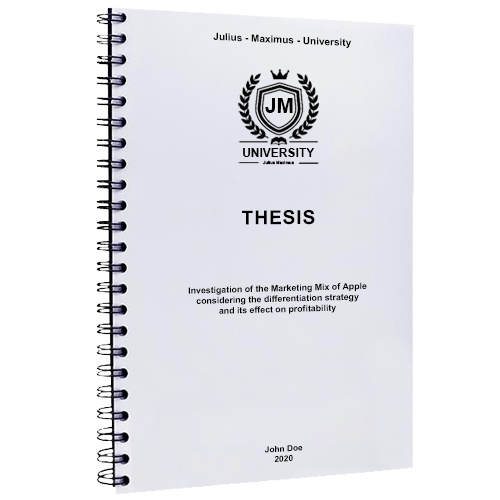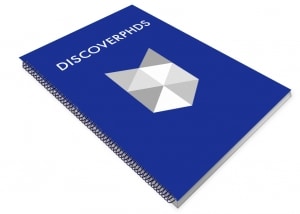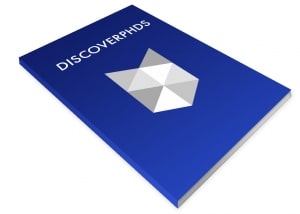
Simplifying College
College and University Blog for Young Success

Printing & Binding a Thesis: The Ultimate How-to Guide
You have studied hard to make it this far. All the hard work towards researching and writing your Bachelor’s thesis, research paper or a different final paper is ending. You have completed your write-up and are ready to submit it to your supervisor. However, one important thing remains – Thesis printing and binding (or thesis binding/thesis printing).
You are probably wondering, “how do I print and bind my thesis? What is the best method and material to use? Where can I find the best service provider to print and bind my thesis?”
Almost every student asks these questions. Finding answers to these questions should no longer stress you out. We compiled resourceful tips that can help you navigate this stage successfully. Read on to gain insightful ideas that you can utilize when working on your thesis or any other research paper.
How do I go about printing and binding my thesis?
If this is your first time printing your research paper, it can be challenging to identify the best method and material to use. In this blog, you will find all the necessary information you need to make an informed decision.
What do I have to watch out for when printing my thesis?
When starting, you will likely ask yourself these questions: • Should the printout be coloured or black and white? • What is the best paper size, quality and brand? • Should the printout be single or double-sided? • How do I find the service provider offering the best services at affordable rates? You no longer have to worry about all that since we have put together all the information you need to answer the above questions.
What do I have to watch out for when binding a thesis?
The first thing you should consider is the guidelines given for your thesis or research paper. If your supervisor or institution has issued specific instructions, it is wise you adhere. Adhering to guidelines for content and structure contributes to your final mark.
If there are no instructions on how to bind your thesis, you can opt for different methods depending on your preferences and stage. For example, you can spiral-bind your regular term paper since it is cheaper and doesn’t have many pages. On the other hand, you may opt for leather binding for your major final paper since it has more pages and the leather is sturdier.
Which binding is the right one for my final paper?
There are several options available, and the choice often depends on your personal preference, institutional requirements, and budget. Here are some options for your final paper:
Leather binding for your thesis

Leather binding is an elegant method where the cover of your thesis is made from leather. This technique has been used for centuries and is highly regarded for its durability, aesthetic appeal, and luxurious feel. You can request the service provider to add corner protectors or decorations to endpapers and headbands for additional aesthetic appeal and structural support.
Recommendations: Leather binding is an excellent option for your; • Master thesis • Bachelor’s thesis • Dissertation • Research paper
Thermal binding for your thesis
This method uses heat to adhere pages together. The front cover is usually transparent, making your thesis title visible at a glance. You can choose different material designs and colours for the back cover.
Recommendation: It is fast, easy to use, and can bind relatively thick documents. It also creates a clean and polished look, making it an ideal final paper.
Softcover for your thesis
Choose a softcover if you want your thesis to look unique and stand out among your peers. Softcover allows you to design the cover with different pictures, writings, logos, or patterns. Simply put, you can design it the way you want. However, do not clutter it with irrelevant stuff since it’s your final paper and should appear professional.
Recommendation: Softcover binding is versatile since you can use it for different types of final papers. It is also cost-effective and allows for easy printing on the spine, making it simple to include the paper’s title, author, and other information. However, the softcover may not be durable, especially where the paper is stacked and retrieved many times. Additionally, it cannot contain many pages, such as those of a comprehensive dissertation.
Spiral binding for your thesis

This method is used to secure multiple pages of a document together. A continuous plastic or metal coil is threaded through small holes punched along the edge of the pages. The coil is then twisted into a tight spiral shape, effectively holding the pages together. Spiral binding utilizes a transparent front cover and a hard back cover.
Recommendation: It is suitable for small projects like term papers.
Where can I go for printing & binding a thesis?
There are several options available for research paper printing and binding, depending on your location. Some common places where you can get your thesis printed and bound include your school print services, local print shops, or order online.
Numerous online platforms specialize in printing. One of the best online prints is BachelorPrint . They offer online services where you can upload your thesis, select printout options, and have the final product delivered to your doorstep through their free express shipping.
How you benefit: • Your document is printed on a high-quality paper at an affordable price • A complete preview of your bound document before shipping • Free express shipping to your location • Your document is delivered on time and in perfect condition
Printing and binding a thesis – making sure nothing goes wrong!
We know that writing and printing your thesis is a serious investment of time, energy, and money. That’s why we have compiled relevant and insightful information that you need to print and bind your Bachelor’s thesis, term paper, or research paper.
We understand that you have the liberty to choose where to print your thesis. However, if you need a tried and tested online service provider, visit BachelorPrint. Their online platform is user-friendly, fast and effective. Once you get in touch with them, you are assured of a stress-free experience.
We wish you success as you finalize your thesis!
Related Posts

Making the Most of the End of a Semester: Tips from a Recent College Graduate

How to Make the Best Use of Your Time: The Ultimate Study Session Guide
- See all Countries
- United Kingdom
- Netherlands
- Switzerland
- Online Learning
Printing and binding a thesis: your ultimate guide

You have finally completed your thesis . It has been a long process of getting your bachelor’s thesis or other college paper to completion. Before you can submit it, high-quality printing and binding is essential. Any student has two concerns when it comes to printing and binding their thesis:
- What is the best way for printing and binding my thesis?
- Which is the best place to have my thesis printed and bonded?
Here is a detailed guideline on salient issues to keep in mind when going about printing and binding your thesis .
What is the best way for printing and binding your thesis?
Most students have never printed and bound any research paper before their thesis paper. Therefore, it may be a difficult task selecting the ideal printing and binding configurations. This article provides all the information you need for printing and binding a thesis.
What issues do I have to keep in mind when printing a thesis?
Some of the questions that are in the minds of students when it comes to printing their papers include:
- Do I print in colour or just black and white?
- Which is the right kind of paper
- Where do I get the best deal so that I can print at a reasonable price?
We have compiled some guidelines on printing a thesis to make it easier for you.
What issues do you have to watch out when binding your thesis?
Most students just think about the ‘how’ to go about binding as they do not know the best type of binding to pick for the thesis. Your choice depends on the type of thesis. A paper that requires extensive research and work, such as research paper may require better binding than your regular term paper that takes just a fraction of the time.
The weight of these papers also differs. Your term paper counts just a small percentage of your final mark where your thesis, whether masters, bachelors or a research paper takes the higher percentage.
Keep in mind: printing and binding your thesis is a very important thing. You should find a appropriate binding to make your dissertation worthy and unique. Here, a simple spiral binder may not be the best choice. It is best to go for leather book binding as it is sturdy and looks worthy of a major paper.
Essentially, the choice of the binding to use depends on the type of college paper that you would like to submit.
Most tertiary institutions have specific requirements when it comes to the type of binding to pick. Therefore, check with your institution, whether there any regulations on printing and binding your paper.
What is the right binding for my paper?
There are several options out there for your binding. We shall explain each to make it easier for you to make a choice.
Printing and binding your thesis with the leather book binding

Our recommendation for important papers: thesis printing and binding with the high-quality leather book binding . The leather-look gives your thesis a solid look, which is classy and professional-looking. When you decide to use BachelorPrint, you are given a wide choice of customized options that include a bookmark, custom embossing and corner protectors to have a superb look for your thesis.
Recommendations:
Leather book binding works great for your final papers such as
- Research Paper
- Bachelor thesis
- Dissertation
- Master’s thesis
Thermal binding as a classic way for printing and binding your thesis

Thermal binding is the most versatile type of binding. Its cover is transparent, thereby allowing you to show the title of your thesis right on the cover. Besides, it comes with a leather-like back cover and you get to choose the colour of the cover. A very good way for printing and binding your thesis.
Recommendation :
Thermal binding works great for smaller research papers. It is also ideal for situations where you need various print-outs of the paper.
The softcover as the most flexible way for printing and binding your thesis

If you would like to have a final paper that looks creative and stands out, consider going for the softcover. This is because it allows you to design the cover in the way you want. There is a wide choice of pictures, fonts and logos available when you need to go wild with your designs, especially if you are quite creative. However, ensure that your paper does not get too cluttered with creative pieces. You are interested in printing and binding your thesis, not a comic – it has to look serious and professional.
Recommendation:
The cheapest way for printing and binding your thesis: the spiral binding

Spiral binding is the simplest binding method and the sleekest. It has similarity to the thermal binding in that you have a transparent front cover and a leather-like back cover with several colour choices. However, unlike other binding types where your pages are glued together, in this case, your papers are held together by spirals. You have a choice of metal or plastic spirals if you decide for printing and binding your thesis with the spiral binding.
Spiral biding works well for small research papers like the term papers. It is not recommended for important, large final papers such as research papers and dissertations.
A quick look at binding methods
We have tabulated the information above about various types of binding to help you determine which would be the best way for printing and binding your thesis.
Where can I get thesis printing and binding services?
We have researched so that you find it easy when going about printing and binding your thesis. We would also like you to know where to get the best quality service. You can consider going to an online printing provider. This allows you to make an order from home, which saves you some time. Even when you are making online orders, it is important that you research on the providers that can offer quality service. In our research, we found one online printer that stood out from many others.

BachelorPrint is your choice thesis printing and binding provider. This authoritative online printing provider offers you several high-quality binding selections. They also have a free express shipping service that ensures that you have your paper soon after it has been printed.
Here are some of the benefits offered
- There is free express shipping to all customers
- There is a 3D preview function where you look at the inside and outside of your thesis in the selected binding using this function on their website.
- They offer high-quality papers at reasonable prices
Ensure everything goes right in your thesis printing and binding
Writing a good thesis takes much time and effort. We guarantee that these tips shared above on Master’s thesis, term paper or dissertation printing and binding , your paper should get ready without any hiccups.
You are the one to determine where your papers will be printed. There is a choice of going to a copy shop or making an order online. However, if you would like to simplify the process of printing and binding your thesis and go for a high-quality paper and a smooth printing and binding process for your final paper, go for BachelorPrint. They have set up a user-friendly online print shop that not only allows you to put together your final thesis but also see how it looks like before it is completed. These are a few reasons why we recommend their services.
We wish you all the best as you complete your thesis!
Search for courses now
The latest articles on studylink.com.
The latest articles from study abroad providers and StudyLink.com to hep you on your study abroad journey.

SOAS University of London

Berliner Hochschule für Technik (BHT)

Alba Graduate Business School

Fontys Academy for the Creative Economy

Howest University of Applied Sciences

International study advice
Read our key advice article to help you make the best decision for your education and start your International study adventure.

In this article we look at how to approach choosing where in the world you would like to study.

Read StudyLink's suggestions on your first steps when deciding where to study abroad, with helpful tips to make your decision easier.

Find out more about English language tests, your options and what is required as an overseas student.

StudyLink.com take a detailed look into the costs of studying abroad and all the aspects that you should budget for when embarking on your studies.

We answer 10 common questions about applying for a student visa to help make your visa application quick and easy.

Find out more about international student visas for studying abroad, as well as how, where and when to apply for yours.

Find out more about funding and scholarships for international students, and what financial assistance might be available to you.

How to choose a course that fits you? Check our top tips on choosing which course is best for you to help you make an informed decision.
Sign up to StudyLink.com
Sign up to StudyLink.com, the home of quality study abroad advice.


Community Blog
Keep up-to-date on postgraduate related issues with our quick reads written by students, postdocs, professors and industry leaders.
Thesis binding and printing options
- By DiscoverPhDs
- November 29, 2020

If you have recently completed your dissertation congratulations are in order! But the work is not finished – you now have to get your dissertation in front of examiners in a professional format. There are a number of factors to consider when producing a physical copy of your thesis :
- Type of binding (for example: helical or softback)
- Paper size (are some pages better suited for A3?)
- Print options (single or double-sided?)
- Paper quality (a range of gsm options are available)
What is Thesis/Dissertation Binding?
Thesis binding involves fastening the physical pages of your dissertation together to produce a single presentable document. As simple as it sounds, there is a lot to get right, and dissertation binding is important in giving a good impression of your work.
What are the different types of dissertation binding?
Spiral/helical/wired binding.
Spiral binding (also known as helical binding) and wired binding are very common for bachelors and masters dissertations. These options give a professional look and allow pages to be rotated 360 degrees, making for easy reading. Spiral binding uses a plastic coil, whilst wire binding uses a metal wire.

Fastback/softback binding
Fastback binding (also referred to as softback binding) uses glue to keep your dissertation pages together. This is not a very common choice for dissertation binding as it is rather formal for bachelors and masters, and perhaps not formal enough for PhD theses. Fastback binding also comes with a risk of glue losing fixity over time leading to pages falling out.

Thermal binding
Thermal binding is not very common but can be used for bachelors or masters dissertations. This type of binding is permanent (so pages cannot be easily added/removed) but is generally inexpensive. Another disadvantage of thermal bindings is that pages cannot be opened 360 degrees (as with fastback binding).

Plastic comb binding
Comb binding involves punching holes down the side of the page and binding with a plastic comb strip. This binding option is also suitable for bachelors and masters dissertations. It is a cheap option but can sometimes become difficult to navigate as pages become stuck on the plastic combing. One advantage of plastic comb binding is that it is easy to add and remove pages.

Paperback binding
Paperback binding will give your manuscript the appearance of a book and comes with personalisation options i.e. a titled cover page, spine and back. This gives a very professional appearance, too formal for a bachelors or masters dissertation, but ideal for a PhD thesis.

Hardback binding
Hardback binding again gives a book like appearance, but is expensive and typically reserved only for PhD theses. In addition to custom titling, spine and back, there is a range of material and colour options for hardback binding e.g. the gold lettering you may have seen on academic books.

What Paper Size Should I use?
Most universities will provide very clear instruction on paper sizes, most often A4. However, some pages such as technical drawings or maps may be best shown on A3. In these cases ‘fold out’ pages are an option but must be approved by your university guidelines.
Print Options:
Check your university guidelines when deciding whether to print single or double sided. If printing double sided, be careful as some pages should not be printed back to back. For example, new chapters should start on the right hand page (of a double spread) so blank pages may be required.
What Paper Quality is Suitable?
Paper thickness is measured in grams per square metre (gsm). Although there is no ideal paper thickness, too thin and you risk your dissertation feeling low quality. Too high and you risk your dissertation pages feeling like cardboard, and again pointing to low quality.
Popular UK Services:
Ryman is an affordable thesis binding service, with a range of options for dissertations and theses. Ryman often have stored on University campuses or nearby, so you can check the services provided by your local store (as an alternative to ordering online).
Doxdirect is an online service which offers a large amount of customisation when choosing a thesis binding option. The door to door service also offers a wide range of delivery and production options so you get your bound thesis in your hand as quick as possible.
Thesis Online has been around for a long time (established in 1920), and have a very good reputation. They offer an online thesis binding service and have a hand online calculator which allows you to modify your binding, printing, and deliver options and see the impact on cost in real-time.
Things to Note:
Whichever service you use to bind your thesis or dissertation, there are a few important things to remember:
When using an online service check the turnaround time. Most services take around a week to print, bind, and deliver, though faster services are available at a cost. Some universities have an onsite printing service that students can use. These services likely offer binding options which satisfy your department’s dissertation submission requirements.
An electronic copy and physical copy of your dissertation will be read differently. Whilst consecutive pages are easy to compare on a computer screen, a physical copy may have pages printed on opposite sides of a single page (if double page printed) which makes side by side comparisons difficult. This is something to consider if your text frequently refers to images or tables overleaf.
Most thesis printing services only accept PDF file formats. Ensure that when you convert your dissertation to PDF that you review the document to ensure no errors occur during conversion.
Check your university dissertation guidance on margin requirements. It is also important to factor in margins when considering binding options. Typically a minimum margin of 2.5cm is required on the side of the page to be bound.
Although it comes with an additional cost, it may be useful to purchase personal copies of your bound thesis. You can then bring your bound copy to your Viva , and ensure that what you and your examiners are looking at are identical.

How should you spend your first week as a PhD student? Here’s are 7 steps to help you get started on your journey.

Learn 10 ways to impress a PhD supervisor for increasing your chances of securing a project, developing a great working relationship and more.

Thinking about applying to a PhD? Then don’t miss out on these 4 tips on how to best prepare your application.
Join thousands of other students and stay up to date with the latest PhD programmes, funding opportunities and advice.

Browse PhDs Now

Find out how you can use Scrivener for PhD Thesis & Dissertation writing to streamline your workflow and make academic writing fun again!

The unit of analysis refers to the main parameter that you’re investigating in your research project or study.

Daniel is a third year PhD student at the University of York. His research is based around self-play training in multiagent systems; training AIs on a game such that they improve overtime.

Ryan is in the final write up stages of his PhD at the University of Southampton. His research is on understanding narrative structure, media specificity and genre in transmedia storytelling.
Join Thousands of Students

How to write a PhD thesis: a step-by-step guide
A draft isn’t a perfect, finished product; it is your opportunity to start getting words down on paper, writes Kelly Louise Preece
Kelly Louise Preece

Created in partnership with


You may also like

Popular resources
.css-1txxx8u{overflow:hidden;max-height:81px;text-indent:0px;} How to develop a researcher mindset as a PhD student
Formative, summative or diagnostic assessment a guide, emotions and learning: what role do emotions play in how and why students learn, how to assess and enhance students’ ai literacy, how hard can it be testing ai detection tools.
Congratulations; you’ve finished your research! Time to write your PhD thesis. This resource will take you through an eight-step plan for drafting your chapters and your thesis as a whole.

Organise your material
Before you start, it’s important to get organised. Take a step back and look at the data you have, then reorganise your research. Which parts of it are central to your thesis and which bits need putting to one side? Label and organise everything using logical folders – make it easy for yourself! Academic and blogger Pat Thomson calls this “Clean up to get clearer” . Thomson suggests these questions to ask yourself before you start writing:
- What data do you have? You might find it useful to write out a list of types of data (your supervisor will find this list useful too.) This list is also an audit document that can go in your thesis. Do you have any for the “cutting room floor”? Take a deep breath and put it in a separate non-thesis file. You can easily retrieve it if it turns out you need it.
- What do you have already written? What chunks of material have you written so far that could form the basis of pieces of the thesis text? They will most likely need to be revised but they are useful starting points. Do you have any holding text? That is material you already know has to be rewritten but contains information that will be the basis of a new piece of text.
- What have you read and what do you still need to read? Are there new texts that you need to consult now after your analysis? What readings can you now put to one side, knowing that they aren’t useful for this thesis – although they might be useful at another time?
- What goes with what? Can you create chunks or themes of materials that are going to form the basis of some chunks of your text, perhaps even chapters?
Once you have assessed and sorted what you have collected and generated you will be in much better shape to approach the big task of composing the dissertation.
Decide on a key message
A key message is a summary of new information communicated in your thesis. You should have started to map this out already in the section on argument and contribution – an overarching argument with building blocks that you will flesh out in individual chapters.
You have already mapped your argument visually, now you need to begin writing it in prose. Following another of Pat Thomson’s exercises, write a “tiny text” thesis abstract. This doesn’t have to be elegant, or indeed the finished product, but it will help you articulate the argument you want your thesis to make. You create a tiny text using a five-paragraph structure:
- The first sentence addresses the broad context. This locates the study in a policy, practice or research field.
- The second sentence establishes a problem related to the broad context you have set out. It often starts with “But”, “Yet” or “However”.
- The third sentence says what specific research has been done. This often starts with “This research” or “I report…”
- The fourth sentence reports the results. Don’t try to be too tricky here, just start with something like: “This study shows,” or “Analysis of the data suggests that…”
- The fifth and final sentence addresses the “So What?” question and makes clear the claim to contribution.
Here’s an example that Thomson provides:
Secondary school arts are in trouble, as the fall in enrolments in arts subjects dramatically attests. However, there is patchy evidence about the benefits of studying arts subjects at school and this makes it hard to argue why the drop in arts enrolments matters. This thesis reports on research which attempts to provide some answers to this problem – a longitudinal study which followed two groups of senior secondary students, one group enrolled in arts subjects and the other not, for three years. The results of the study demonstrate the benefits of young people’s engagement in arts activities, both in and out of school, as well as the connections between the two. The study not only adds to what is known about the benefits of both formal and informal arts education but also provides robust evidence for policymakers and practitioners arguing for the benefits of the arts. You can find out more about tiny texts and thesis abstracts on Thomson’s blog.
- Writing tips for higher education professionals
- Resource collection on academic writing
- What is your academic writing temperament?
Write a plan
You might not be a planner when it comes to writing. You might prefer to sit, type and think through ideas as you go. That’s OK. Everybody works differently. But one of the benefits of planning your writing is that your plan can help you when you get stuck. It can help with writer’s block (more on this shortly!) but also maintain clarity of intention and purpose in your writing.
You can do this by creating a thesis skeleton or storyboard , planning the order of your chapters, thinking of potential titles (which may change at a later stage), noting down what each chapter/section will cover and considering how many words you will dedicate to each chapter (make sure the total doesn’t exceed the maximum word limit allowed).
Use your plan to help prompt your writing when you get stuck and to develop clarity in your writing.
Some starting points include:
- This chapter will argue that…
- This section illustrates that…
- This paragraph provides evidence that…
Of course, we wish it werethat easy. But you need to approach your first draft as exactly that: a draft. It isn’t a perfect, finished product; it is your opportunity to start getting words down on paper. Start with whichever chapter you feel you want to write first; you don’t necessarily have to write the introduction first. Depending on your research, you may find it easier to begin with your empirical/data chapters.
Vitae advocates for the “three draft approach” to help with this and to stop you from focusing on finding exactly the right word or transition as part of your first draft.

This resource originally appeared on Researcher Development .
Kelly Louse Preece is head of educator development at the University of Exeter.
If you would like advice and insight from academics and university staff delivered direct to your inbox each week, sign up for the Campus newsletter .
How to develop a researcher mindset as a PhD student
A diy guide to starting your own journal, contextual learning: linking learning to the real world, what does a university faculty senate do, hybrid learning through podcasts: a practical approach, how exactly does research get funded.
Register for free
and unlock a host of features on the THE site

- $ 0.00 0 items
Thesis Binding
Thesis Book Binding or Dissertation Book Binding is the conversion of your thesis or dissertation document into a printed and bound book format. Getting this done correctly involves several considerations that includes the Submission of your document for printing and binding, your choice of Paper, and the Style of binding you want.
SUBMITTING YOUR THESIS OR DISSERTATION FOR BINDING:
The first consideration for Thesis Book Binding or Dissertation Book Binding is whether you want your thesis or dissertation printed and bound for official submission or for your personal use, such as gifts to professors, departments, libraries, parents, sponsors, or you just want copies to preserve for future generations.
If you are officially submitting your Thesis Book Binding or Dissertation Book Binding books to your
institution, you must follow their official guidelines for paper, margins, and type of binding. Every institution has
guidelines and your can ask your department or your graduate studies department for the guidelines. The quote/
ordering process for each of our 3 main types of binding is designed to accommodate all the options that most
schools require.
Binding Options Our 3 main binding options are:
- Fabric Hardcover Binding with Gold Embossed Lettering and Emblem on the cover https://phdbookbinding.com/fabric-hard-cover/
- Printed Hardcover Binding with wraparound full color printing on the cover https://phdbookbinding.com/printed-hard-cover/
- Perfect Binding Softcover with wraparound full color printing on the cover https://phdbookbinding.com/perfect-binding/
But if you’re getting the books for personal use, then you have the option to choose the type of paper, binding and margin size that you prefer. Here again, our quote/order process contains all the options you might want.
Digital or Paper Submission
The second consideration is whether you want to submit a file or paper document(s) for publishing your Thesis or Dissertation. You have the option to place your order with a PDF file or with a paper document. Submitting a PDF file ( https://phdbookbinding.com/digital-printing/#2 ) of your Thesis or Dissertation allows you to do the following online, sit back and forget about it, and receive your books in the mail:
- Specify the size of your book
- Choose the type of paper you want for printing ( https://phdbookbinding.com/digital-printing/#9 )
- Specify the pages you want to print in color. ( https://phdbookbinding.com/faq/#9 ) Yes, we allow you to specify the pages you want to print in color and you’ll be charged the color rate ONLY for the pages you specify,NOT for all the pages in your document.
- Specify the exact lettering you want on the cover ( https://phdbookbinding.com/gold-foil-emblem-and-lettering/ )
- Specify the exact lettering you want on the spine ( https://phdbookbinding.com/gold-foil-emblem-and-lettering/ )
- Specify your school emblem for the cover or request a custom emblem ( https://phdbookbinding.com/gold-foil-emblem-and-lettering/#SealList )
- Choose the shipping speed you want for getting back the completed book(s)
Digital Submission
The option for submitting a PDF file for printing and binding is available for all the binding styles that we offer, including:
- Fabric Hardcover Binding with Gold Embossed Lettering and Decoration on the cover https://phdbookbinding.com/fabric-hard-cover/
- Printed Hardcover Binding with wraparound full color printing on the cover https://phdbookbinding.com/printed-hard-cover/
Submitting a Paper document of your Thesis or Dissertation requires you to
(1) Print your document on the paper of your choice
(2) Fill out the Quote/Order form on this site for the type of Hardcover binding you want
(3) Specify the exact lettering you want on the cover
(4) Specify the exact lettering you want on the spine
(5) Choose the shipping speed you want for getting back the completed book(s)
(6) Print a form on our site that will include the details you entered PLUS final instructions for mailing your
paper document to us
(7) Ship to us your paper document(s) with instructions on form you will print from our site.
The option for submitting a paper document for binding ONLY is available ONLY for Hardcover binding.
Fabric Hardcover Binding with Gold Embossed Lettering and Decoration on the cover
https://phdbookbinding.com/fabric-hard-cover/
Printed Hardcover Binding with wraparound full color printing on the cover
https://phdbookbinding.com/printed-hard-cover/
Paper document submission is not available for Softcover Perfect Binding.
PAPER CHOICE
The second consideration for Thesis Book Binding or Dissertation Book Binding is choosing the type of paper that you want. We offer 5 types of paper as listed below and as explained here in greater detail ( https://phdbookbinding.com/digital-printing/ )
20lb regular or standard Copy Paper. This paper is ACID-FREE and is white in color. It does not have a watermark. Acid Free paper is made from wood pulp, and it resists yellowing and brittleness over very long periods (measured in centuries). The production of Acid Free paper is also more environmentally friendly than acidic paper.
60lb regular or standard Copy Paper (also known as 24lb Copy Paper)*. This paper is ACID-FREE and is white in color. It does not have a watermark. Acid Free paper is made from wood pulp, and it resists yellowing and brittleness over very long periods (measured in centuries). The production of Acid Free paper is also more environmentally friendly than acidic paper. (See below for why this paper has 2 different names)
20lb, 25% Cotton Paper. This white paper is ACID-FREE and ARCHIVAL. It has a WATERMARK which is visible only when you shine a bright light behind the sheet. Archival paper has all the benefits of Acid-Free paper, except that it resists yellowing and brittleness even longer than ordinary Acid-Free paper. Another difference is that Cotton Paper is made with cotton pulp.
24lb, 100% Cotton Paper . This white paper is ACID-FREE and ARCHIVAL. It has a WATERMARK which is visible only when you shine a bright light behind the sheet. Archival paper has all the benefits of Acid-Free paper, except that it resists yellowing and brittleness even longer than ordinary Acid-Free paper. Another difference isthat Cotton Paper is made with cotton pulp. PLEASE NOTE that A4 (European Letter size) is NOT available in 100% cotton.
80lb Gloss-Coated Paper. This paper is ACID-FREE and is white in color. It does not have a watermark. But unlike regular copy paper, it is also coated with a gloss finish that makes it perfect for printing photos, charts & graphs, and more.
80lb Matte-Coated Paper. This paper is ACID-FREE and is white in color. It does not have a watermark. But unlike regular copy paper, it is also coated with a matte (non-gloss coating) finish that makes it perfect for printing photos, charts & graphs, and more.
BINDING STYLE
The binding style you choose depends first on whether you’re submitting officially to your institution or for personal use. We offer 3 types of binding Fabric Hardcover Binding with Gold Lettering and Gold Emblem ( https://phdbookbinding.com/fabric-hard-cover/ )
Most institutions require Fabric Hardcover Binding with gold lettering or gold emblem for official submission. You can also choose this type of binding for your own personal copies and as gifts because it is binding of the highest quality that is impressive in look and feel. Fabric Hardcover binding is high quality, archival binding that’s fit for the most demanding public or private library. Fabric options include:
- Classic Buckram fabric that is available in different colors,
- Contemporary Levant finish fabric also available in different colors
- Cowhide available in 3 colors
Lettering and emblem are applied to Fabric Hardcover binding with gold embossing
Printed Hardcover Binding ( https://phdbookbinding.com/printed-hard-cover/ )
Institutions may also allow Printed Hardcover Binding for Thesis and Dissertations. Printed Hardcover Binding allows:
- Background color of your choice
- Lettering color of your choice
- Full color emblem
- Image and text on back cover, or
- Wraparound full-color cover design
Printed Hardcover Binding can be compared to Fabric Hardcover Binding on this page: https://phdbookbinding.com/comparison/
Perfect Binding (Softcover, Paperback binding) ( https://phdbookbinding.com/perfect-binding/ )
Perfect Binding is Softcover, Paperback binding that allows all the options available for Printed Hardcover binding
Recommended pages
- Lecture timetables
- Campus maps
- Student digital services
- Staff Digital Services
- Student support
- Online registration
- Core systems
- Car parking
- Room bookings
- Staff development
Do I need to get my thesis hardbound or softbound?
- Question Answered
- Rate this answer
- College of Arts and Law
- College of Engineering and Physical Sciences
- College of Life and Environmental Sciences
- College of Medical and Dental Sciences
- College of Social Sciences
Professional Services
- Academic Services
- Campus Services
- Development and Alumni Relations
- Executive Support
- External Relations
- Human Resources
- IT Services
- Legal Services
- Research Strategy and Services

Study at Cambridge
About the university, research at cambridge.
- Undergraduate courses
- Events and open days
- Fees and finance
- Postgraduate courses
- How to apply
- Postgraduate events
- Fees and funding
- International students
- Continuing education
- Executive and professional education
- Courses in education
- How the University and Colleges work
- Term dates and calendars
- Visiting the University
- Annual reports
- Equality and diversity
- A global university
- Public engagement
- Give to Cambridge
- For Cambridge students
- For our researchers
- Business and enterprise
- Colleges & departments
- Email & phone search
- Museums & collections
- Open Research
- Share Your Research
- Open Research overview
- Share Your Research overview
- Open Research Position Statement
- Scholarly Communication overview
- Join the discussion overview
- Author tools overview
- Publishing Schol Comm research overview
- Open Access overview
- Open Access policies overview
- Places to find OA content
- Open Access Monographs overview
- Open Access Infrastructure
- Repository overview
- How to Deposit overview
- Digital Object Identifiers (DOI)
- Request a Copy
- Copyright overview
- Third party copyright
- Licensing options
- Creative Commons
- Authorship and IP
- Copyright and VLE
- Copyright resources
- Events overview
- Training overview
- Contact overview
- Governance overview
Your hardbound thesis and third party copyright
- Scholarly Communication
- Open Access
- Training and Events
Which items of third party copyright do I need to seek permission to include in my hardbound thesis?
In copyright terms your hardbound thesis is an unpublished work upon deposit in the University Library.
If it stays unpublished, and you have included extracts of others’ copyright works, say brief quotations, your use of the third party extract may be covered by the statutory exception of ‘fair dealing for the purpose of illustration for instruction’ , including for examination purposes (s. 32 of the Copyright, Designs and Patents Act 1988 (CDPA)). This is because your hardbound thesis is considered an examination script, i.e. an answer to an exam question.
The ‘fair dealing for the purpose of illustration for instruction’ exception applies to those extracts, excerpts or quotations from works included in a dissertation for examination and deposit in unpublished form in the University Library, but not its publication after examination, in hard copy or online, including in an online repository such as the Apollo Repository. In other words, the exception applies to the use of short extracts of others’ works in a dissertation that is to be examined but not to subsequent publication of that dissertation, including online.
The statutory exception of ‘illustration for instruction’ is a ‘fair dealing’ exception, which means:
- you may copy only what is reasonably required, i.e. include a portion of another’s work that is necessary for the immediate purpose of illustrating a point in your paper, and
- your use of another’s work must not impact adversely on exploitation of the work by its owner, e.g. material made available under the illustration for instruction exception must not be made available online in the Apollo Repository, or on another website such as a Faculty or Departmental website, in social media etc.; images such as photographs of works of art may be used as long as the purpose is for illustration for instruction and the images are provided in low-resolution; and
- author and publication details of the source work must be acknowledged unless to do so is impractical.
Open Research Newsletter sign-up
Please contact us at [email protected] to be added to the mailing list to receive our quarterly e-Newsletter.
The Office of Scholarly Communication sends this Newsletter to its subscribers in order to disseminate information relevant to open access, research data management, scholarly communication and open research topics. For details on how the personal information you enter here is used, please see our privacy policy .
Privacy Policy
© 2024 University of Cambridge
- Contact the University
- Accessibility
- Freedom of information
- Privacy policy and cookies
- Statement on Modern Slavery
- Terms and conditions
- University A-Z
- Undergraduate
- Postgraduate
- Research news
- About research at Cambridge
- Spotlight on...
Types of Thesis Binding & Optional Extras
by Mark at Pilot | Thesis binding

[UPDATED]: In this blog post we thought we’d explain, in a bit more detail, the various thesis printing and binding options available at The Document Centre, London . Here we look at the options in the same order as they appear on the online order form , so that it’s possible to cross-refer. The photo montage above also illustrates many of the options discussed. So, first up are the options for printing of the actual pages …
Standard Printing Options:
For the internal pages of the thesis or dissertation, our standard paper is 100gsm and is excellent quality, suitable for both pin-sharp text and vivid photographs and graphics. The pages are printed digitally using our state-of-the-art digital printers. During the ordering process you can specify how many pages are to be printed in black and white, and how many are to be in full colour (you can have a mix of both and do not normally need to tell us which pages are which as that is usually self-evident within the PDF you supply). Specifying the correct quantity of each, however, will give you an accurate final price for your order.
Unless the ‘ I require double-sided printing ‘ box is checked during the online ordering process, we print internal pages single-sided by default. This is because virtually all universities specify single-sided printing in their thesis/dissertation printing specifications. However you can overrule that, i.e. have double-sided printing, by checking the box if you wish.
Types of Binding Available:
When it comes to thesis binding , most universities require ‘hard’ or ‘soft’ binding but there are some exceptions so we’ll go through all the various binding options available so that it covers all possible university specifications:
Hard binding (usually used for final submission of a thesis/dissertation): this is a style of bookbinding which is rather like traditional hard-back books i.e. the covers and spine are strong and very rigid while internal pages are securely bound in. As with hardback books you’d see in a bookshop, the covers extend slightly further than the internal pages. Our hard-bound theses and dissertations come with a ‘library buckram cloth’ covering which has a pleasant texture and is hard-wearing. A large range of colours are available to suit any university specification. On the online order form you can choose to have metallic foil lettering on the front cover should you wish (for university thesis binding it will usually appear on the spine by default).
Soft binding is a little similar to hard binding (see above) except the covers are not as thick and therefore not as rigid and the internal pages are thermally glued in. However the finished book is still usually able to stand unaided on a book shelf. The covers and spine are covered in a library buckram book cloth although, unlike with hard binding, the outer covers are cut flush with the internal pages. This type of bookbinding is often used for first submission of your thesis or dissertation. The buckram covering is available in a large range of colours to suit any university specification and, for university dissertations, gold or silver foil lettering usually also appears on the spine, by default.
Wiro binding: this method of document binding uses a wire coil (or spiral) to hold the pages together. The pages are first punched with a series of regularly-spaced holes near the binding edge and then the wire spine is clamped down through the holes in the pages so as to keep them in place. The wire spine comes in several colours and also allows the document pages to be turned through 360 degrees and to open completely flat if required. Usually a transparent cover is included at the front end and a card cover at the back. Wiro binding can usually be done while-you-wait, without an appointment.
Velo binding: this is another simple and fast method of document binding and, as such, can also be done in-store while you wait, usually without an appointment. Like wiro binding, velo binding also comes with a transparent plastic front cover and card back cover and the pages also have regularly punched holes (but just 12 in number for velo) near the spine. Different, though, is the binding method; with velo binding the document is bound using a 12-pin binding system which is able to bind up to 600 sheets of paper (3 inches max.) which is way beyond the capability of wiro binding. Universities like King’s College have started to specify this binding system for theses and dissertations in recent times. Learn more about velo binding here .
Thermal binding: as with velo and wiro binding, thermal binding also usually comes with a clear plastic front cover and card back cover and is quick and easy (so can also usually be done while you wait). The binding mechanism is via thermal (hot) glue rather than any physical ‘spine’ addition. Thermal binding is also known as Glue binding, Fastback, Thermo and Perfect binding.
Optional Extras:
As well as the standard printing and binding options outlined above, other optional extras include:
A plastic pocket to hold a CD or DVD. Usually this is positioned in the inside of the back cover but you are free to instruct us otherwise if you prefer it elsewhere (there is a space for special instructions towards the end of the online ordering process).
A CD can be burned or copied so that it contains your file(s). This can be housed in a plastic pocket which can be supplied loose or inserted into your binding, as you prefer. As above there is a space for any special instructions towards the end of the online ordering process.
A plastic corner pocket which can house loose inserts can be glued to the inside back cover, or other location — even left loose if you prefer to position it yourself.
A cloth corner pocket (suitable for hardbound books only) can be supplied instead of the plastic variety. This is positioned on the inside back cover board and can contain loose inserts etc.
A cloth ‘register’ ribbon (again for hardbinding only) can be bound into the book, for use as a bookmark. A variety of colours are available.
Foil (shiny metallic) lettering: For hard and soft binding for university theses, we usually add silver or gold foil lettering to the spines by default. However for hard binding we can also foil on the front cover (as is appropriate for your particular university). Gold is the default so tick the override box if you need silver foil instead. On the online order form , within the ‘ Binding Style & Presentation ‘ section near the bottom, fill in the appropriate fields for things like the university, degree, first name, family name and so on, and please check your spelling carefully before submitting your order because we will print what you supply.
Turnaround Times
You have quite a range of options to choose from, including:
- 2 hour turnaround (available during all but our busiest months – orders being processed between 9am and 3pm);
- 4 hour turnaround (available during all but our busiest months – orders being processed between 9am and 1pm);
- Same day turnaround (orders must be received by 10.30am in order to be available from 3.30pm the same working day);
- 2 working day turnaround (orders must be received by 10.30am for that day to count as the first day);
- 3 working day turnaround (orders must be received by 10.30am for that day to count as the first day).
Please note that turnaround times are for week days only ; weekends are not counted as working days.
Example: Order by 10.30am latest on a Monday morning and, if you ordered a 3 day service, your order will be ready by 3.30pm on the Wednesday.
Free Delivery to many London Universities
Once completed, bound dissertations/theses can be delivered free to certain London universities and institutions. These are: Berkbeck College (WC1), James C Maxwell Building, Franklin-Wilkins Building, SOAS, Imperial College, Gower Street, King’s College (Guy’s and Strand campuses), Courtaulds (Strand), The Institute of Education, the London School of Tropical Medicine, Christie’s Education and Regent’s Business School. More can be seen on the Delivery section of the online order form .
It is also possible, when ordering, to specify a different 2nd and 3rd delivery address for any duplicate copies being ordered. So we could send one to your university and another to your home address, for example.
So — whatever specification is required, we have it covered at The Document Centre. All dissertations are bound to the exact university specifications required (unless you tell us otherwise) and, as you can see above, there is a huge amount of flexibility regarding optional extras, turnaround times and even delivery. As the first bookbinders to bring in online ordering of thesis binding into the UK, we have things down to a fine art and are a ‘preferred supplier’ for many of the UK’s universities. To order your thesis binding online click here , contact us or see a map of our London location here , here or simply call us on 0207 928 9738 . Lastly, for more about our printing, bookbinding and thesis binding services and the types of binding available, click here .
Recent Posts
- The History of Bookbinding
- 7 Great Ideas for Writing Your Own Book
- How to Write your Life Story
- Bespoke Bookbinding
- Bookbinding
- Dissertation Printing & Binding
- Large Format Printing
- Perfect Binding
- Printing & Bookbinding Services
- Printing services
- Rapid printing & document binding services
- The Document Centre
- Theses & Dissertations
- Thesis binding
- Thesis printing & binding services
- Uncategorized
- University dissertation printing & binding
- University news
- University thesis
- University thesis services
Thesis Preparation & Submission
The final examination of a candidate for a Research Masters or PhD degree is based on the explanation of the candidate’s research in a thesis describing the context, nature, methodology and outcomes of the research, prepared in accordance with international norms.
- You will prepare your thesis under the direction of the Principal Supervisor and with the support of your Research Studies Panel. Please liaise with both on your thesis
- The Thesis Submission Guidelines outlines the process for preparation, submission, processing and examination of graduate research degree theses. The Theses in Graduate Research Programmes Policy identifies the responsibilities of each party within the University with respect to the preparation, submission, processing, examination, and dissemination of graduate research degree theses.
See Thesis Submission Dates
Submission of Thesis for Examination
- You must be a fully registered student and not owe any fees at the time when your thesis is submitted for examination.
You may submit your thesis in 2 ways:
1. via the UCD eThesis System : please see here for further information. Through the system, you will be able to submit your thesis electronically, verify authorship and programme compliance, and track progress through all stages of the examination process.
2. via hard copy: ( note:subject to restrictions due to COVID-19: please see FAQ for further info )
You submit to the Student Desk in the Tierney Building as many soft bound copies of the thesis as there are members on your Examination Committee. There are usually three people on the Examination Committee i.e. internal examiner, extern examiner and the Chair of the Examination Committee. The members of your examination committee are listed on the "UView - Student Enquiry" Screen on your UCD student SIS Web account under the heading "Other Advisors". The theses must be accompanied by a completed Research Degree Examination Form signed by both you and your Principal Supervisor (download Research Degree Examination Form /access here in our Documents & Files).
Submission of Final Thesis
Following the viva voce examination for PhD students and once you have the approval of the internal examiner that you have met the requirements of the Examination Committee you follow these steps:
- Step 1: produce a hardbound copy of your thesis
- eThesis submission: no corrections sign-off form needed with hardbound thesis
- Traditional submission: corrections sign-off form needed with hardbound thesis
- Step 3: you submit the hardbound thesis to the UCD Student Desk with the signed Thesis Correction Sign Off Form ( note: subject to restrictions due to COVID-19: please see FAQ for further info )
Further Resources
Documents & files.
View or download the most useful policies, regulations and forms for graduate research students
PhD Lifecycle
View the lifecycle of the PhD programme at UCD, from application to conferring
Viva Voce Examination
View guidance and procedures relating to the viva voce oral examination

Study at Cambridge
About the university, research at cambridge.
- Undergraduate courses
- Events and open days
- Fees and finance
- Postgraduate courses
- How to apply
- Postgraduate events
- Fees and funding
- International students
- Continuing education
- Executive and professional education
- Courses in education
- How the University and Colleges work
- Term dates and calendars
- Visiting the University
- Annual reports
- Equality and diversity
- A global university
- Public engagement
- Give to Cambridge
- For Cambridge students
- For our researchers
- Business and enterprise
- Colleges & departments
- Email & phone search
- Museums & collections
- Undergraduate and Postgraduate Taught
- Postgraduate examinations
- Writing, submitting and examination
- PhD, EdD, MSc, MLitt
- Cambridge students
- New students overview
- Pre-arrival courses
- Student registration overview
- Information for New Students
- Information for Continuing Students
- Frequently Asked Questions overview
- Who needs to register
- When to register
- Received registration in error/not received registration email
- Problems creating an account
- Problems logging in
- Problems with screen display
- Personal details changed/incorrectly displayed
- Course details changed/incorrectly displayed
- Accessing email and other services
- Miscellaneous questions
- Contact Form
- First few weeks
- Manage your student information overview
- Student record overview
- Camsis overview
- Extended Self-Service (ESS)
- Logging into CamSIS
- What CamSIS can do for you
- Personal information overview
- Changing your name
- Changing Colleges
- Residing outside the University's precincts
- Applying for person(s) to join you in Cambridge
- Postgraduate students overview
- Code of Practice for Master's students
- Code of Practice for Research Students
- Postgraduate student information
- Requirements for research degrees
- Terms of study
- Your progress
- Rules and legal compliance overview
- Freedom of speech
- Public gatherings
- Disclosure and barring service overview
- Cambridge life overview
- Student unions
- Extra-curricular activities overview
- Registering societies
- Military, air, and sea training
- Food and accommodation
- Transport overview
- Bicycles and boats
- Your course overview
- Undergraduate study
- Postgraduate study overview
- Changes to your student status (postgraduates only) overview
- Applying for a change in your student status (postgraduates only)
- Changing your mode of study
- Withdrawing from the University
- Allowance/exemption of research terms
- Withdrawal from Study
- Reinstatement
- Changing your course registration
- Changing your department/faculty
- Changing your supervisor
- Exemption from the University composition fee
- Confirmation of Study: Academic Verification Letters
- Extending your submission date
- Medical intermission (postgraduates)
- Non-medical intermission (postgraduates)
- Returning from medical intermission
- Working away
- Working while you study
- Postgraduate by Research Exam Information
- Research passports
- Engagement and feedback
- Student elections
- Graduation and what next? overview
- Degree Ceremonies overview
- The ceremony
- Academical dress
- Photography
- Degree ceremony dates
- Eligibility
- The Cambridge MA overview
- Degrees Under Statute B II 2
- Degree certificates and transcripts overview
- Academic Transcripts
- Degree Certificates
- After Graduation
- Verification of Cambridge degrees
- After your examination
- Exams overview
- Undergraduate and Postgraduate Taught overview
- All students timetable
- Undergraduate exam information overview
- Postgraduate examinations overview
- Examination access arrangements overview
- Research programmes
- Taught programmes
- Writing, submitting and examination overview
- PhD, EdD, MSc, MLitt overview
- Research Best Practice
- Preparing to submit your thesis
- Submitting your thesis
- Word limits
- The oral examination (viva)
- After the viva (oral examination)
- After the examination overview
- Degree approval and conferment overview
- Final thesis submission
- Examination allowances for certain Postgraduate degrees (except PhD, MSc, MLitt and MPhil by thesis degrees)
- Requesting a review of the results of an examination (postgraduate qualifications)
- Higher degrees overview
- Higher doctorates
- Bachelor of divinity
- PhD under Special Regulations
- Faith-provision in University exams
- Publication of Results
- Exam Support
- Postgraduate by Research
- EAMC overview
- Annual Reports of the EAMC
- Dates of meetings
- Frequently asked questions
- Guidance notes and application forms
- Resources overview
- Build your skills
- Research students
- Fees and financial assistance overview
- Financial assistance overview
- General eligibility principles and guidance
- Cambridge Bursary Scheme funding overview
- What you could get
- Scottish students
- EU students
- Clinical medics and vets
- Independent students
- Extra scholarships and awards
- Undergraduate Financial Assistance Fund
- Postgraduate Financial Assistance Fund
- Realise Financial Assistance Fund
- The Crane Fund
- Loan Fund I
- External Support
- Support from your Funding Sponsor
- Guidance for Academic Supervisors and College Tutors
- Fees overview
- Funding overview
- Mosley, Worts, and Frere Travel Funds
- Support for UKRI Studentship Holders
- Student loans overview
- US loans overview
- Application procedure
- Entrance and Exit Counselling
- Cost of attendance
- What type of loan and how much you can borrow
- Interest rates for federal student loans
- Proof of funding for visa purposes
- Disbursement
- Satisfactory academic progress policy
- In-School Deferment Forms
- Leave of absence
- Withdrawing and return to Title IV policy
- Rights and Responsibilities as a Borrower
- Managing Repayment
- Consumer information
- Submitting a thesis — information for PhD students
- Private loans
- Veteran affairs benefits
- Frequently Asked Questions
- Student support
Submitting your thesis for examination (PhD, EdD, MD, BusD, MLitt, MSc)
Format of the thesis, the thesis must:.
be written in British English, apart from quotations and recognised technical formulae
be in A4 portrait format
use one-and-a-half spaced type
include any photographs or other illustrations scanned into the text
be saved in the electronic format and naming style specified by your Degree Committee
Examiners are not expected to edit work. They will deal with errors of fact and typographical errors that affect the meaning of your work, as well as larger structural issues. The extent to which the text has or has not been properly prepared may influence their recommendation concerning the award of the degree. You are therefore advised to check your thesis thoroughly prior to submission to ensure clear, formal British English has been used throughout and that there are minimal typing and/or spelling mistakes.
How and when to present the thesis for examination
You must submit an electronic copy of your thesis for examination, and any required accompanying documents, to your Degree Committee by your submission deadline (which can be found under 'Thesis Submission details' on the Academic tile in your CamSIS self-service). If you are not a self-funded student, the terms and conditions of your funding may require you to submit your thesis earlier than the date shown in CamSIS. If you are unsure what your funder-expected submission date is, you should contact your Funding Administrator. You are required to submit your thesis for examination by your deadline even if the date falls over a weekend or holiday period.
Your Degree Committee should provide you with guidance for electronic submission; please contact them directly if you require any assistance.
The thesis you submit to your Degree Committee will be the thesis forwarded to the examiners for examination. It is not possible to 'retract submission' or to send a revised copy directly to your examiners. Therefore you should carefully check the file(s) you upload when submitting your thesis.
Postgraduate students must keep a minimum number of terms of research before they can submit (for example, 9 for the full-time PhD or 15 for the part-time PhD or EdD) unless they have been granted an allowance or exemption of terms . If you attempt to submit too early and have not had an allowance or exemption of terms approved, your thesis submission will not be accepted or will be kept on hold and not forwarded to your examiners until the first day of your 9th (full-time) or 15th (part-time) term.
Requirements
You must include the following bound inside your thesis:
Please ensure the pages are in the correct order. This is very important - if these preliminary pages are in a different order in your final hardbound thesis to your thesis submitted for examination, this could cause problems and delay approval for your degree.
1. A title page displaying:
the full title of the thesis
your full legal name (as it appears on your passport, marriage certificate or deed poll)
your college
the date of submission (month and year)
a declaration stating: "This thesis is submitted for the degree of Doctor of Philosophy/Doctor of Education/Doctor of Business/Doctor of Medicine/Master of Science/Master of Letters (as appropriate)."
2. A declaration in the preface stating:
'This thesis is the result of my own work and includes nothing which is the outcome of work done in collaboration except as declared in the preface and specified in the text. It is not substantially the same as any work that has already been submitted, or, is being concurrently submitted, for any degree, diploma or other qualification at the University of Cambridge or any other University or similar institution except as declared in the preface and specified in the text. It does not exceed the prescribed word limit for the relevant Degree Committee.'
The declaration does not need to be signed . For more information on the word limits for the respective Degree Committees see Word Limits and Requirements of your Degree Committee )
3. An abstract/summary of your thesis
4. [if applicable] the list of additional materials that were approved for submission alongside the thesis
You must also submit the following documents (not included inside the thesis):
Required: One declaration form
Optional: Research Impact Statement If pandemic, war/conflict, or natural disaster have significantly impacted on your research, you are invited to submit a Research Impact Statement with your thesis using the template provided. The purpose of the statement is for you to describe any restrictions or difficulties experienced in undertaking your research as a result of pandemic, war/conflict, or natural disaster, and to provide details of any alternative arrangements made to complete the work for your thesis. Further details for students and supervisors can be found in the Research Impact Statement guidance and the Research Impact Statement form can be downloaded here .
Inclusion of additional materials
Students other than those in the Faculty of Music must seek permission through their CamSIS Self Service page if they wish to submit additional materials for examination alongside their thesis. Additional materials are integral to the thesis but in a format that cannot be easily included in the main body of the thesis (for example, 3D graphics). You should refer to the ' Policy on the inclusion of additional materials with a thesis ' before making an application to include additional materials. This process should be initiated prior to the thesis submission. If a thesis is submitted with additional materials and without permission to include them, it will be held by the Degree Committee until approval is confirmed.
Please bear in mind that if you are granted permission to submit additional materials, you are required to upload the same materials to the University repository, Apollo , when you submit your approved thesis post-examination (doctoral candidates only). Therefore, the inclusion of additional material that contains uncleared third-party copyright or sensitive material may affect the access level that is most appropriate for your thesis.
Submitting a revised thesis
If you are resubmitting your thesis following a viva outcome of being allowed to revise and resubmit the thesis for examination for a doctoral degree, you need to follow the same procedure as for the original thesis submission .
What happens following submission of the thesis for examination
When you submit your thesis for examination the Degree Committee will check the submission, acknowledge receipt, and inform Student Registry you have submitted. The Student Registry will update your CamSIS record.
The Degree Committee will forward your thesis to your examiners. If you have not received confirmation of the date of your viva (oral examination) within six weeks of submitting your thesis, or if you have any questions with regard to your thesis at this stage, you should contact your Degree Committee.
Your Examiners should not ask you for a printed copy of your thesis or other material in advance of your viva (oral examination). If they do, please seek advice from your Degree Committee.
© 2024 University of Cambridge
- Contact the University
- Accessibility
- Freedom of information
- Privacy policy and cookies
- Statement on Modern Slavery
- Terms and conditions
- University A-Z
- Undergraduate
- Postgraduate
- Research news
- About research at Cambridge
- Spotlight on...
- Graduate School
- Current Students
- Dissertation & Thesis Preparation
Formatting Requirements
Page layout, margins and numbering, workday student support.
Graduate students can find "how to" guides and support information on our Workday support page .
Your scholarly approach may call for a different presentational method. These are the requirements and recommendations for text-based theses.
For a text-based thesis, or the text portions of a thesis, the page size must be 8.5" x 11", and the text must be in a single, page-wide column. Do not use two or more columns in your thesis.
The text of the thesis is written in paragraph form.
- the first line of each paragraph should be indented, OR
- there should be a larger space between paragraphs than there is between lines.
Each chapter should generally start at the top of a new page.
Left: 1.25 inches (32 mm) is recommended if you intend to bind copies of your thesis; 1 inch minimum.
Right, top, and bottom: 1 inch recommended; 0.75 inches (19 mm) minimum
Page Numbering
Preliminary pages:.
- must be numbered in lower case Roman numerals (ii, iii, iv, etc.)
- the title page is "i" but this number must not appear on the page
- numbering begins at "ii" on the committee page
- the first page of the abstract is page iii
Body of thesis:
- must be numbered in Arabic numerals (1, 2, 3, etc.)
- the first page of the text is "1"
- subsequent pages are numbered continuously throughout, including pages with tables and figures, bibliographies, appendices, and index
Whole thesis:
- every page except the title page must have a number on it
- there must be no blank pages in the thesis.
Page numberS:
- must be placed at least .5 inches (12 mm) from the edge of the page
- may be either in the lower centre or on the top or lower right of the page, when the page is viewed in portrait view. Lower right is preferred.
Landscape Pages
Landscape pages must be orientated in your PDF so that they are readable without rotation. You do not need to change the location or orientation of the page number, but may if you wish.
Facing Pages
Facing pages are not acceptable; you must use one-sided layout and pagination. If the caption for a figure, table, etc., cannot appear on the same page as its accompanying illustration, place the illustration on a separate page after the caption.
- Why Grad School at UBC?
- Graduate Degree Programs
- Application & Admission
- Info Sessions
- Research Supervisors
- Research Projects
- Indigenous Students
- International Students
- Tuition, Fees & Cost of Living
- Newly Admitted
- Student Status & Classification
- Student Responsibilities
- Supervision & Advising
- Managing your Program
- Health, Wellbeing and Safety
- Professional Development
- Final Doctoral Exam
- Final Dissertation & Thesis Submission
- Life in Vancouver
- Vancouver Campus
- Graduate Student Spaces
- Graduate Life Centre
- Life as a Grad Student
- Graduate Student Ambassadors
- Meet our Students
- Award Opportunities
- Award Guidelines
- Minimum Funding Policy for PhD Students
- Killam Awards & Fellowships
- Policies & Procedures
- Information for Supervisors
- Dean's Message
- Leadership Team
- Strategic Plan & Priorities
- Vision & Mission
- Equity, Diversity & Inclusion
- Initiatives, Plans & Reports
- Graduate Education Analysis & Research
- Media Enquiries
- Newsletters
- Giving to Graduate Studies
Strategic Priorities
- Strategic Plan 2019-2024
- Improving Student Funding
- Promoting Excellence in Graduate Programs
- Enhancing Graduate Supervision
- Advancing Indigenous Inclusion
- Supporting Student Development and Success
- Reimagining Graduate Education
- Enriching the Student Experience
Initiatives
- Public Scholars Initiative
- 3 Minute Thesis (3MT)
- PhD Career Outcomes

COMMENTS
1. the 'Deposit & Copying of Hardbound Thesis Declaration' form must be bound into your final hardbound thesis as the very first page. Do not include this form in the electronic version. 2. title page, displaying: the full title of the thesis; your full legal name (as it appears on your passport, marriage certificate or deed poll); your college ...
Thermal binding for your thesis. This method uses heat to adhere pages together. The front cover is usually transparent, making your thesis title visible at a glance. You can choose different material designs and colours for the back cover. Recommendation: It is fast, easy to use, and can bind relatively thick documents.
A Guide to Hard-Binding Your Thesis 1. The standard size for a printed thesis is A4: 297x210mm. 2. Double sided printing is acceptable for the hard bound copy. 3. The thesis should be bound in black cloth (Arbelave library Buckram shade 585 or the closest match). 4. The spine should contain the following information in gold lettering, with the text
Comb binding (± $5) Plastic comb binding is a cheaper alternative to spiral binding. Its main advantage is that the binding can be opened and closed (although not easily), meaning pages can be added or removed: ideal for a draft. A transparent front and back cover can be added. Low cost.
Thermal binding as a classic way for printing and binding your thesis. Thermal binding is the most versatile type of binding. Its cover is transparent, thereby allowing you to show the title of your thesis right on the cover. Besides, it comes with a leather-like back cover and you get to choose the colour of the cover.
Spiral/Helical/Wired binding. Spiral binding (also known as helical binding) and wired binding are very common for bachelors and masters dissertations. These options give a professional look and allow pages to be rotated 360 degrees, making for easy reading. Spiral binding uses a plastic coil, whilst wire binding uses a metal wire.
It often starts with "But", "Yet" or "However". The third sentence says what specific research has been done. This often starts with "This research" or "I report…". The fourth sentence reports the results. Don't try to be too tricky here, just start with something like: "This study shows," or "Analysis of the data ...
For coursework programmes, two (2) hardbound copies should be submitted to the Faculty together with two (2) soft copies in CD (PDF) format after corrections of dissertation/project have been endorsed by the examiner(s). A Master's thesis/dissertation should be hardbound in dark blue colour,
Thesis Book Binding or Dissertation Book Binding is the conversion of your thesis or dissertation document into a printed and bound book format. Getting this done correctly involves several considerations that includes the Submission of your document for printing and binding, your choice of Paper, and the Style of binding you want.
If you are submitting your thesis for examination for the first time, your thesis should be soft bound. If you are submitting your corrected thesis, it is your choice whether your thesis is soft bound or hard bound. If it has been confirmed that you have been awarded your research degree and you are submitting the final copy of your thesis ...
In copyright terms your hardbound thesis is an unpublished work upon deposit in the University Library. If it stays unpublished, and you have included extracts of others' copyright works, say brief quotations, your use of the third party extract may be covered by the statutory exception of 'fair dealing for the purpose of illustration for ...
Types of Binding Available: When it comes to thesis binding, most universities require 'hard' or 'soft' binding but there are some exceptions so we'll go through all the various binding options available so that it covers all possible university specifications: Hard binding (usually used for final submission of a thesis/dissertation ...
The hardbound copy of the thesis had a more impressive appearance than the softbound one. ... While it's true that softbound books are generally less durable, that doesn't mean they are of lower quality. Softbound books are a popular choice for many types of books, including novels, poetry collections, and academic texts. ...
Step 1: produce a hardbound copy of your thesis. Step 2: the Internal examiner will sign the Thesis Correction Sign Off Form to confirm that all the necessary corrections have been completed to the satisfaction of the examiners. eThesis submission: no corrections sign-off form needed with hardbound thesis. Traditional submission: corrections ...
Format of the thesis The thesis must: ... They will deal with errors of fact and typographical errors that affect the meaning of your work, as well as larger structural issues. ... if these preliminary pages are in a different order in your final hardbound thesis to your thesis submitted for examination, this could cause problems and delay ...
The thesis abstract should be summarized to about 300 words for this purpose. (ii) The thesis is to be bound into a book form with A4 size. (iii) 80gm paper should be used for the printing of the thesis to enhance the quality of printing on both sides of the paper. (iv) Cover of the thesis are as follows: PhD Thesis Master Thesis
In this case, you will have a certain period (often three months) to make the corrections, which the internal examiner will check before formally accepting the thesis. (There is usually no second viva on the corrected thesis.) In this case, the date on the hardbound thesis should be the date that the corrected version is completed and given to ...
HOME | SCHOOL OF GRADUATE STUDIES
practice manuscripts shall be covered with dark blue hardbound book cover. Special Problem manuscripts shall be covered with chocolate brown hardbound book cover. Crocodile-skin covers shall not be used. 2.2.b. Thesis, Field Practice and Special Problem manuscripts shall be covered with transparent plastic for added protection. Section 2.3 ...
This video is a step by step tutorial for making an imbossed harbound which can be use especially for making a thesis.
Your scholarly approach may call for a different presentational method. These are the requirements and recommendations for text-based theses. Page Size For a text-based thesis, or the text portions of a thesis, the page size must be 8.5" x 11", and the text must be in a single, page-wide column. Do not use two or more columns in your thesis. Paragraphs The text of the thesis is written in ...
2.5 Typing. The thesis should be typed out on a computer in Times New Roman font, size 12, and using Microsoft Word version 6.0 or later, except for tables and figures (refer to. 1.14.2 and 1.14.3). Words in a language that is different from the language of the thesis must be typed in italics.
a. Thesis/Dissertation Title on Hardcover . i. The thesis/dissertation title should be typed in capital letters, bold, and font size 18. ii. The title should be centred in between the left and right margins (inverted pyramid). iii. .Use single spacing . for . title. s with . more than one line iv. Do not use abbreviations in the title. v.
The thesis abstract should be summarized to about 300 words for this purpose. (ii) The thesis is to be bound into a book form with B5 size. (iii) 80gm paper should be used for the printing of the thesis to enhance the quality of printing on both sides of the paper. (iv) Cover of the thesis are as follows: PhD Thesis
No; from 1 January 2024, there is no longer a requirement in University Regulations to deposit a hardbound copy of your final thesis in order for your degree to be formally conferred at a degree congregation. Information on the changes to the thesis deposit can be found on the Library Services page.